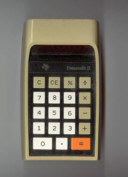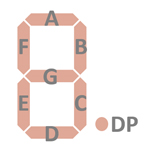
DATAMATH CALCULATOR MUSEUM
 |
DATAMATH CALCULATOR MUSEUM |
Characterization of Hitachi Single-chip Calculator Circuits
The DCM-50A Platform supports the Characterization of many Non-TI single-chip calculator circuits with up to 42-pin packages using the DCM-50A Playground DIL42 Adapter mounted on top of the DCM-50A PG Frame Carrier with the voltages VSS and VDD/VGG set to the appropriate levels.
| • Package Markings Top:
HD3633 5A 41 B • Package Markings Bottom: • Donor Calculator: Lloyd's Accumatic 30 (Model EH-9036, Type 255C), February 1975 |
Keyboard: The Lloyd's Accumatic 30 makes use of a keyboard assembly with 19 spring-supported plastic keys pushing small fingers on stamped sheet-metal pieces against contacts etched on a single-sided phenolic PCB. All switches but the [C] key are arranged in a 5*4 matrix with the rows connected to the KS1-KS5 Outputs (Keyboard Scan) and the columns connected to the K1 to K4 Inputs (Keyboard Scan) of the LI2002 single-chip calculator circuit. The [C] key is connected directly between VSS and the KC Input of the HD3633.
Keyboard Matrix of the Lloyd's Accumatic 30 (Model EH-9036, Type 255C):
HD3633 | |||||
| K1 | K2 | K3 | K4 | KC | |
| VSS | C | ||||
| KS1 | 1 | 2 | × | . | |
| KS2 | 3 | 4 | ÷ | +/− | |
| KS3 | 5 | 6 | + | ||
| KS4 | 7 | 8 | − | % | |
| KS5 | 9 | 0 | = | CE | |
![]() Display: The
Lloyd's Accumatic 30 makes use 28 Volts. An additional discrete red LED
is used as minus sign for negative numbers and connected between a transistor
activated with Digit Output D1 and Segment Output G.
Display: The
Lloyd's Accumatic 30 makes use 28 Volts. An additional discrete red LED
is used as minus sign for negative numbers and connected between a transistor
activated with Digit Output D1 and Segment Output G.
Display Layout:
| Futaba 8-CT-02 plus LED |
|
|
| The Segment drivers A-G and DP (Decimal Point) are connected to the Futaba 8-CT-02 display in the pictured way. |  |
Display Fonts:
| Type | Calculator | Number Fonts | Decimal Separator |
Thousands Separator |
Entry Overflow |
Calculating Overflow |
Minus |
| HD3633 | Lloyd's Accumatic 30 |
n.a. | 8 leading digits of the result |
Note: The HD3633 is signaling error conditions like calculator overflow or division by zero with a 'C' or 'E' in the rightmost D1 display position - which is missing with the 8-digit Futaba 8-CT-02 display used with the Lloyd's Accumatic 30.

 Keyboard Scanning: The
HD3633 single-chip calculator circuits provides five dedicated keyboard scanning
outputs KS1 to KS5 of its eight
segment outputs to scan the keyboard during each display scanning cycle. Only the
necessary digit-driver outputs are activated, when displaying a "0." only D2
would be enabled. The D1 Digit Time is used for the minus sign and error
conditions. The provided recording
shows the scanning activity of the HD3633 while holding down the [9] key located in the keyboard scan matrix of
keyboard scanning output KS5 and keyboard input K1 was registered while displaying "9.".
Please notice that KS1 and KS4 are permanently activated while KS2, KS3 and KS5.
Keyboard Scanning: The
HD3633 single-chip calculator circuits provides five dedicated keyboard scanning
outputs KS1 to KS5 of its eight
segment outputs to scan the keyboard during each display scanning cycle. Only the
necessary digit-driver outputs are activated, when displaying a "0." only D2
would be enabled. The D1 Digit Time is used for the minus sign and error
conditions. The provided recording
shows the scanning activity of the HD3633 while holding down the [9] key located in the keyboard scan matrix of
keyboard scanning output KS5 and keyboard input K1 was registered while displaying "9.".
Please notice that KS1 and KS4 are permanently activated while KS2, KS3 and KS5.
Display
scanning: Display scanning is performed in D1 → D9 direction at a rate of
about 1,100 Hz:
|
• State Time = 1 Clock =
0.0125 ms @ CK=80 kHz • Digit Time = 8 States = 0.1 ms @ CK=80 kHz • Scan Time = 9 Digit Times (D1 to D9) = 0.90 ms @ CK=80 kHz |
| • Package Markings Top: HD36290 5D
21 • Package Markings Bottom: • Donor Calculator: Lloyd's Accumatic 30 (Model EH-9036, Type 255D), June 1975 |
Keyboard: The Lloyd's Accumatic 30 makes use of a keyboard assembly with 19 spring-supported plastic keys pushing small fingers on stamped sheet-metal pieces against contacts etched on a single-sided phenolic PCB. All switches but the [C] key are arranged in a 9*2 matrix with the rows connected to the D0-D8 Outputs (Display Scan) and the columns connected to the KN (Keyboard Scan Numerical) and KF (Keyboard Scan Functions) Inputs of the HD36290 single-chip calculator circuit. The [C] key is connected directly between VSS and the KC Input of the HD36290.
Keyboard Matrix of the Lloyd's Accumatic 30 (Model EH-9036, Type 255D):
HD36290 | |||
| KN | KF | KC | |
| VSS | C | ||
| D0 | 1 | 0 | |
| D1 | 2 | . | |
| D2 | 3 | + | |
| D3 | 4 | − | |
| D4 | 5 | × | |
| D5 | 6 | ÷ | |
| D6 | 7 | % | |
| D7 | 8 | = | |
| D8 | 9 | CE | |
![]() Display: The
Lloyd's Accumatic 30 makes use of an 9-digit Futaba 9-CT-08
low-voltage Vacuum Fluorescent Display (VFD) connected directly to the
respective 9 Digit Outputs D1 to D9 and 8 Segment Outputs SA to SG and SDP of
the HD36290 and biased to approximately -28 Volts.
Display: The
Lloyd's Accumatic 30 makes use of an 9-digit Futaba 9-CT-08
low-voltage Vacuum Fluorescent Display (VFD) connected directly to the
respective 9 Digit Outputs D1 to D9 and 8 Segment Outputs SA to SG and SDP of
the HD36290 and biased to approximately -28 Volts.
Display Layout:
| Futaba 9-CT-08 |
|
|
| The Segment drivers A-G and DP (Decimal Point) are connected to the Futaba 9-CT-08 display in the pictured way. |  |
Display Fonts:
| Type | Calculator | Number Fonts | Decimal Separator |
Thousands Separator |
Entry Overflow |
Calculating Overflow |
Minus |
| HD36290 | Lloyd's Accumatic 30 |
n.a. |
Scanning: Display and keyboard Scanning is performed in D0 → D9 direction at a rate of about
1,100 Hz: with the Digits blanked at State S1 and State S8:
|
• State Time = 1 Clocks = 0.01 ms @ CK=100 kHz • Digit Time = 8 States = 0.08 ms @ CK=100 kHz • Scan Time = 11 Digit Times (D0 to D10 with D10 a dead cycle) = 0.88 ms @ CK=100 kHz |
If you have additions to the above article please email: joerg@datamath.org.
© Joerg Woerner, November 12, 2024. No reprints without written permission.